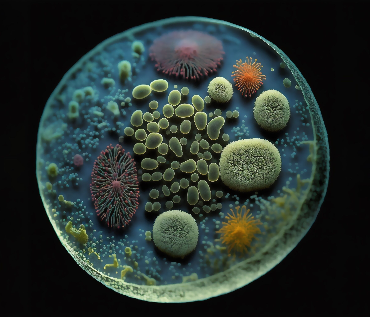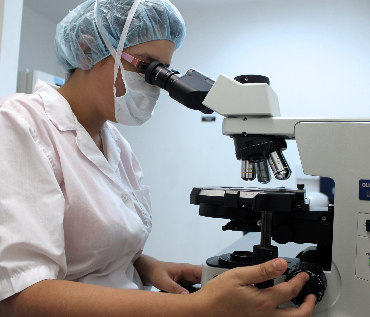Table Of Contents
2. Measurement and analysis of important factors are necessary for particle characterization
3. How are Artificial Intelligence and Machine Learning Used in Particle Characterization
5. How Artificial Intelligence Has Transformed Nanoparticle Characterization?
6. How the Use of AI/ML for Particle Characterisation Has Helped the Pharmaceutical Industry?
7. How the Use of AI and Machine Learning Will Shape the Future of Particle Characterization?
Introduction
The process of examining and comprehending the characteristics and behavior of particles is known as particle characterization. Particles can vary in size, shape, content, and other attributes. They can be solid, liquid, or gaseous. Particle characterization aims to offer comprehensive details about these particles so that their physical, chemical, and biological characteristics may be better understood.
Many scientific and industrial sectors, including materials research, medicines, environmental science, nanotechnology, and chemical engineering, depend on the ability to characterize particles. Researchers and engineers can better understand particle interactions, behavior, and effects on numerous systems and processes by researching particles.
Measurement And Analysis Of Important Factors Are Necessary For Particle Characterisation
1) Particle Size Analysis: Understanding a particle's behavior, responsiveness, and performance depends on its size. Different methods, including microscopy, laser diffraction, sedimentation, or dynamic light scattering, can be used to analyze particle size.
2) Particle Shape: Particle shapes affect their physical and chemical characteristics, as well as how they behave in various situations. Methods like microscopy, image analysis, or automated shape characterization algorithms are used to describe particle shapes.
3) Particle Composition: Determining the components, compounds, or functional groups that are present in a particle by analyzing its chemical makeup. Particle composition is ascertained using methods like spectroscopy, elemental analysis, or mass spectrometry.
4) Surface Properties: Particles' surface properties, such as their surface area, porosity, charge, or wettability, have a big impact on how well they interact with other particles and substances. Common surface analysis methods include zeta potential measurement, contact angle measurement, and BET (Brunauer-Emmett-Teller) analysis.
5) Particle Concentration: Determining the number of particles or their concentration in a sample is necessary to comprehend their abundance and dispersion. Particle concentrations are measured using techniques like microscope counting, flow cytometry, or particle counters.
Scientists and engineers may fully grasp the characteristics, behavior, and interactions of particles by characterizing them using these and other pertinent factors. In several sectors and research domains, this information facilitates the creation and optimization of materials, processes, and technologies.

How Are Artificial Intelligence And Machine Learning Used In Particle Characterization?
Particle characterization is increasingly using artificial intelligence (AI) and machine learning (ML) approaches to examine and comprehend complicated particle systems.
Here are some examples of applications of AI and ML in this area:
a) Image Analysis: Images of particles obtained by microscopy methods may be analyzed using AI and ML algorithms. ML models may be taught to recognize and categorize various types of particles based on their size, shape, color, and other properties by being trained on a collection of labeled photos. This makes particle recognition and characterization automatic and precise.
b) Particle Tracking: Monitoring the behavior and movement of particles in a system is essential to comprehending their characteristics. Particles may be tracked in real-time or from recorded films using AI and ML approaches. Researchers can glean useful statistics from the trajectory data, including particle velocity, diffusion coefficients, and interactions between particles.
c) Feature Extraction: To describe the characteristics of particle data, ML systems may extract pertinent features. Examples of characteristics that ML models may learn to extract from particle photos or other types of particle data include statistical measurements, fractal dimensions, and texture properties. Then, these characteristics can be utilized to categorize particles or foretell their physicochemical characteristics.
d) Data Analysis And Modelling: AI and ML may be used to analyze sizable datasets of measurements of particle characterization, including particle size distribution, composition, and surface characteristics. ML models can spot patterns, correlations, and trends in the data that conventional analytic techniques can find difficult to spot. These models can also be employed to develop particle behavior prediction models or to enhance particle production procedures.
e) Simulation And Modelling: Particle simulation models can be more accurate and effective when AI and ML approaches are used with them. To calibrate and improve simulation models, machine learning (ML) algorithms may learn from experimental data. This allows for more accurate predictions of particle behavior under varied circumstances. When it comes to complicated particle systems, where analytical solutions are less common, this is very helpful.
f) Real-Time Decision-Making: Real-time decision-making and control systems for particle characterization procedures can be aided by AI and ML. ML models may offer insights and suggestions for process optimization, quality control, and anomaly detection by continually observing and examining particle data. This may result in increased particle characterization efficiency, dependability, and product consistency.
Overall, automated analysis, pattern identification, prediction, and process optimization are made possible by AI and ML approaches, which provide strong tools for particle characterization. They promote improvements in several disciplines, including materials research, medicines, environmental science, and nanotechnology, and they help us understand particle systems better.
Which Are The Newly Developed Technologies For Particle Characterization Based On Machine Learning?
In recent years, several newly created machine learning (ML)--based particle characterization methods have appeared. To improve particle analysis and offer more precise and effective characterization, these technologies make use of ML algorithms. Here are some illustrations:
A) Deep Learning For Image Analysis — Convolutional neural networks (CNNs) are a popular deep learning approach for image analysis in particle characterization. These models are capable of automatically identifying and categorizing particles based on their characteristics in microscope pictures. They can also obtain exact measurements of particle size, shape, and other characteristics, obviating the need for manual examination.
B)/Reinforcement Learning For Particle Tracking — Algorithms for reinforcement learning (RL) have been used to solve particle tracking issues. Real-time learning (RL) models develop their tracking techniques over time by interacting with a tracking environment and learning to track particles. Particularly in complicated systems or under difficult imaging conditions, this method can increase the precision and effectiveness of particle tracking algorithms.
C) Generative Adversarial Networks For Data Augmentation (GANs)— For data augmentation in particle characterization, ML models of the GAN type are utilized. To increase the training dataset for ML models, GANs may create synthetic particle pictures that mimic genuine particle images. This enables ML algorithms for particle analysis tasks to become more robust and broader.
D) Transfer Learning For Generalisation— Using limited data, transfer learning is a technique that enables ML models to use information from one domain to perform better in another. Transfer learning can be used in particle characterization to adapt previously learned models from related disciplines or well-characterized particle systems to novel and understudied particle types or experimental configurations. This makes it possible to analyze novel particle systems more quickly and accurately.
E) Active Learning For Data Labelling— This method actively chooses the most instructive samples for annotation, which optimizes the data labeling process. Active learning techniques can prioritize which particles in particle characterization need to be manually labeled to train ML models more efficiently. This keeps model performance high while reducing the total labeling effort.
With unprecedented opportunities for automation, precision, and optimization in the study of complex particle systems, these technologies demonstrate the promise of machine learning (ML) in particle characterization. To address particular issues and enhance particle characterization methods, researchers continue to investigate and create novel ML-based ways. ipvPSA a microscopic particle analyser by ImageProVision offers significant process material evaluation using ML technology.
How Artificial Intelligence Has Transformed Nanoparticle Characterization?
By providing a more effective, precise, and automated examination of complicated nanoparticle systems, artificial intelligence (AI) has substantially changed nanoparticle characterization.
Following are some ways AI has influenced this industry:
1) Automated Image Analysis
Microscopy methods are frequently used to characterize nanoparticles, producing a significant amount of picture data. To analyze these photos and automatically identify and categorize nanoparticles based on their size, shape, and other characteristics, AI algorithms, particularly deep learning models, can be taught. This automation cuts down on the need for manual analysis, saves time, and keeps accuracy high. E.g. ipvNano (Nanoparticle analyzer) by ImageProVision uses a unique algorithm for nanoparticle analysis.
2) Improved Particle Identification
Object identification algorithms and other AI approaches can help identify and locate nanoparticles in photos. These methods enable the accurate identification of nanoparticles in complicated or noisy pictures, resulting in more dependable and consistent nanoparticle characterization findings.
3) Size And Form Analysis
Using pictures from microscopy, AI systems can precisely determine the size and form of nanoparticles. AI can learn to extract exact measurements, even for nanoparticles with irregular shapes, by training models on labeled datasets. By doing away with manual measurements, a more uniform and impartial examination of size and shape is provided.
4) Particle Tracking And Dynamics
AI-based tracking systems can monitor nanoparticle motion and behavior in real-time or from previously recorded movies. AI models may gain useful knowledge about the diffusion, interactions, and aggregation of nanoparticles by studying particle paths. This aids in comprehending the dynamics of nanoparticles and how they affect diverse applications.
5) Data Analysis And Pattern Recognition
AI can manage massive datasets and uncover significant patterns, correlations, and trends in data related to the characterization of nanoparticles. Researchers can gain new insights and improve the techniques used to synthesize nanoparticles by using machine learning algorithms, which can detect subtle correlations between nanoparticle attributes and experimental settings.
6) Simulation And Design Optimization
To improve the precision and effectiveness of nanoparticle simulation models, AI approaches can be included. With the use of AI, simulation models may be calibrated and improved using experimental data to produce predictions of nanoparticle behavior that are more accurate. This makes it possible for researchers to more successfully optimize the production and design of nanoparticles.
By automating operations, enhancing accuracy, enabling sophisticated data analysis, and aiding the creation and optimization of nanoparticles for numerous applications, the use of AI in nanoparticle characterization has revolutionized the area. Research and development activities have been increased as a result, resulting in improvements in the fields of nanotechnology, materials science, biomedical engineering, and other related disciplines.
How The Use Of AI/ML For Particle Characterisation Has Helped The Pharmaceutical Industry?
The pharmaceutical sector has benefited greatly from the adoption of artificial intelligence (AI) and machine learning (ML) approaches for particle characterization.
Here are some examples of how AI and ML have aided particle characterization:
Increased Efficiency and Accuracy: Large collections of particle pictures may be analyzed by AI and ML algorithms more rapidly and correctly than by using manual techniques. They can quantify characteristics including size, shape, texture, and composition, categorize particles, and extract features. As a result, particle characterization procedures used in the pharmaceutical business operate more effectively and consistently.
High-Throughput Analysis: AI and ML make it possible to analyze particle pictures in a high-throughput manner, which enables the quick identification and characterization of enormous numbers of particles. To ensure uniform medication delivery and performance, pharmaceutical companies must evaluate the size, shape, and homogeneity of drug particles. This is very useful in drug formulation and quality control.
Process Optimisation: By analyzing and associating particle properties with process factors, AI and ML may improve particle production processes. AI and ML algorithms may assist in optimizing process settings to attain desired particle characteristics, resulting in enhanced medicine product performance and quality. This is done by finding the association between process factors and particle qualities.
AI and ML algorithms may identify and categorize flaws or impurities in pharmaceutical particles or formulations. These algorithms may spot quality requirements that have not been met, such as aggregation, unusual forms, or contaminants, by examining particle pictures. This contributes to maintaining the reliability and security of medicinal goods.
Formulation creation: By examining particle qualities and their effect on drug performance, AI and ML algorithms can help in the creation of optimized drug formulations. These methods aid in the formulation of pharmaceuticals with increased effectiveness, solubility, and controlled release features by linking particle parameters with drug release patterns, stability, and bioavailability.
Predictive Modelling: Using AI and ML algorithms, predictive models may be created that link particle properties to medicine efficacy or other important quality aspects. These models may be used to improve formulations, forecast how particles would behave under various circumstances, and provide guidance for decision-making throughout the development and production of pharmaceuticals.
Real-time monitoring and management of particle characterization operations are made possible by AI and ML approaches. These methods can give instant feedback on particle quality by analyzing particle pictures in real-time, ensuring prompt interventions to preserve process stability and product uniformity.
Overall, the pharmaceutical business has benefited from using AI and ML for particle characterization thanks to improvements in accuracy, effectiveness, and process optimization. It has improved quality control, made high-throughput analysis possible, and aided in the creation of improved medicine formulations.
Pharmaceutical businesses can hasten the development of new drugs, improve quality control, and provide patients with safer and more effective medication by using the potential of AI and ML. Tech companies like ImageProVision cater tailor-made AI and ML-based particle characterization solutions to their pharmaceutical clients.
How The Implementation Of AI and Machine Learning Will Shape The Future Of Particle Characterization?
AI and machine learning will make it possible to monitor and manage particle characterization procedures in real-time. For process optimization, quality assurance, and anomaly detection, machine learning models may continually analyze data streams and give feedback. The efficiency and cost-effectiveness of particle characterization methods will increase as a result, as will their dependability, consistency, and yield.
By integrating AI and ML methods, particle simulation models will become more accurate and effective. To calibrate and improve simulation models, machine learning algorithms can learn from experimental data, resulting in predictions of particle behavior that are more accurate. By allowing for virtual testing and optimization before actual trials, this integration will improve our understanding of and ability to build particle systems.
AI will make it easier to combine and analyze many characterization modalities and approaches. ML models will be created to handle a variety of data sources, including dynamic measurements, spectroscopic data, and microscope pictures. These models will synergistically incorporate data from several methodologies, giving particles a more thorough and precise characterization.
Companies like ImageProVision have developed ipvHot, a hot-stage microscopy integrated with thermal analysis enabling the study of materials as a function of temperature and time.
Data-driven innovation and discovery will be fuelled by AI and ML in the particle characterization field. AI models will discover unique particle features, behaviors, and interactions that may have gone missing in the past by using huge and varied datasets.
New opportunities for particle creation, research, and industrial use will result from this. Automation, sophisticated data analysis, predictive modeling, and integration with simulation models are just a few of the ways that AI and ML will fundamentally change particle characterization.
These innovations will speed up research, enhance process control, and make it easier to create and optimize particles for a variety of applications. Innovations and data-driven insights will shape the future of particle characterization, reshaping fields including materials research, healthcare, environmental science, and more.
Summing It Up
As we move forward, the cooperation & teamwork between AL, ML, and Particle Analysis hold great commitment for the advancement in several areas such as pharmaceuticals, materials science, environmental science, and beyond. The evolving landscape of AI and ML applications in particle analysis indicates a major transformation, where technology has come to be a crucial partner in unraveling the complications of the microscopic industry.
Reference: Claude AI UK




